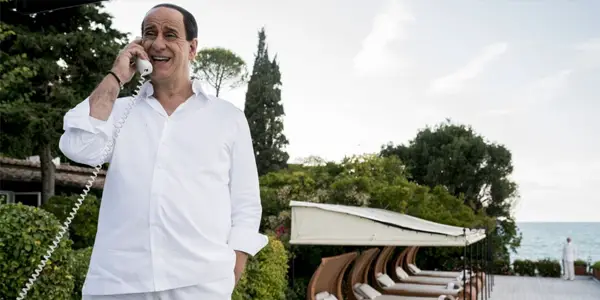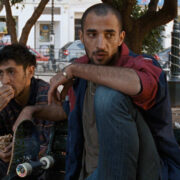The 2018 Lavazza Italian Film Festival Report: LORO & BOYS CRY

Alex is a 28 year-old West Australian who has a…
When it comes to Australia’s arthouse cinemas, the rolling parade of international film festivals never stop. Within the next few months, we’ve got the Greek, Italian, Russian, Jewish, Japanese and Iranian Film Festivals touring here, each with their own unique contributions to the world of international cinema.
Recently, the 2018 Lavazza Italian Film Festival offered audiences a diverse array of Italy’s latest theatrical releases, which included Happy as Lazzaro, Dogman and Loro, as well as a range of romantic dramas, old-school classics, queer comedies, and weighty crime thrillers. So when it arrived in Perth, I jumped at the opportunity to check out two of them: the striking political biopic Loro and the solemn crime drama Boys Cry (I was able to catch Happy as Lazzaro and Dogman earlier this year at Melbourne International Film Festival).
Loro (Paolo Sorrentino)

To describe Paolo Sorrentino as a director who likes to have his cake and eat it too might be underestimating the absolute decadence of the Italian auteur’s boisterous style, as through his eyes, having your cake and eating it too simply isn’t enough: it’s hundreds of cakes, served upon golden platters, presented by an array of bikini-clad models, all eaten within rich, neon-lit parties. Loro (“them” in Italian) continues his reputation of delivering films with a slick visual inventiveness, with Sorrentino’s name becoming synonymous with an elaborate and outrageous visual indulgence, usually at the expense of narrative momentum or any sense of subtlety. Cut down from two 100 minute features, Loro arrives in one hefty 2 and a half hour package (dubbed the international cut), which manages to showcase the best and worst qualities of the Oscar-winning successor to Fellini’s opulent throne, which is proven within the first five minutes of this film alone, as we get glimpses of sex, drugs and a dying goat.
This time, Sorrentino, with a screenplay co-written by Umberto Contarello, has set his sights on Silvio Berlusconi, the larger-than-life media mogul turned former Prime Minister of Italy. Played to satirical perfection by Sorrentino’s frequent collaborator Toni Servillo, Loro avoids being a glorified Wikipedia entry by choosing to focus on the brief period between 2006 to 2009 where, after the fall of his third government, the playful billionaire briefly backed away from the spotlight in order to dodge the constant news reports about his corrupt nature and frequent tax dodging. But of course, this didn’t stop him from constantly indulging in his social and carnal pleasures, much to the chagrin of his worn-out wife Veronica (an icy Elena Sofia Ricci).
It’s interesting then, that despite of all of his real-life controversies, Loro decides to frame Berlusconi’s story within the manner of The Great Gatsby, with the powerful politician staging a series of lavish parties. But instead of pining for a lost love, it’s his lost youth that constantly evades him, which seems to be the dagger in the sides of every one of Sorrentino’s protagonists (most notably in Youth, which the title alone makes pretty clear). By this interpretation, Riccardo Scamarcio (last seen in John Wick: Chapter 2) is our introduction into this corrupt world, a self-proposed “talent scout” who is the Nick Carraway to Berlusconi’s Gatsby, an ambitious but hopelessly naive entrepreneur who wishes to use Berlusconi’s influence to catapult himself into a cushy political gig.
Sergio is a man who exists in a dreamworld of available sex, booze and drugs, a fantasy solidified in one colourful sequence where MDMA pills literally rain from the sky, as he hosts his own excessive party to catch the eye of the evasive politician. Despite Sergio being our entrance into this story (the first 45 minutes are purely focused on his exploits to meet the man), it seems that, in the transition from merging the two separate films together, Sergio’s arc got lost in the mix, as he virtually disappears once Sorrentino switches focus onto the 70-year-old Berlusconi’s domestic dramas.
The plot might be centred on Berlusconi, but Luca Bigazzi’s wonderfully vibrant camerawork often looks elsewhere, mostly at the barely-clothed women that fill out every scene, which brings forth the hypocrisy that Scorsese’s The Wolf of Wall Street was accused of; its hard to spend 2 hours brazenly gazing upon a plethora of attractive men and women, only to spend the final minutes condemning that very act. The criticism of Berlusconi and his lifestyle feels a bit too little, too late, who at best only receives a severe finger-waving for his decades of lawlessness (whilst severely avoiding any moral complications regarding his career).
The superficiality of Berlusconi’s appearance, with his thick make-up, big wrinkly grin and jet-black soy sauce hair dye, suggests a mask, hiding a contrasting personality underneath the facade. Unfortunately, despite its mammoth run-time, the best Sorrentino can define him as is a pervy puppet-master, which is ironic considering how much his dolled up face makes him look like a marionette puppet (there’s a lot of obvious Donald Trump comparisons to be made as well). For all of his flamboyant stylistic flourishes, Sorrentino creates a visual sheen so seductive that it collapses into mere rhetoric, and despite this whole film, I still don’t know if the director loves or loathes Berlusconi, but I can confirm one thing – he sure loves his parties.
Boys Cry (Damiano D’Innocenzo, Fabio D’Innocenzo)

Into every life a little rain must fall, but not necessarily the deluge that engulfs the two teenagers at the centre of Boys Cry, the joyless debut feature from Damiano D’Innocenzo and Fabio D’Innocenzo (dubbed the D’Innocenzo Brothers). Working off their own screenplay, the brother’s festival film owes a considerable debt to Matteo Garrone’s Gomorrah, the Italian neo-realism gangster drama that took back the excess and growing superficiality of Hollywood’s depiction of the mafia, popularised by directors like Scorsese and De Palma, and replanted the genre into a more recognisable, realistic world. This ain’t Goodfellas, nobody wears a suit or laughs lavishly at the tables of a casino; instead the criminal underworld takes place within dingy sheds, the uniform of choice is cheap Adidas jackets, and all of the illegal activities take place in the bombed-out, deserted outskirts of Rome.
It’s appropriate that this unglamorous location paints a picture that seems post-apocalyptic, because the two pizza delivery drivers stuck in it, Mirko (Matteo Olivetti) and Manolo (Andrea Carpenzano), envision themselves without a future. Complacent to tend bar within the next few years, their destinies are quickly changed when on the way home from work, the pair accidentally run over a man, and in a nervous panic, flee the scene of the crime. They quickly confess to Manolo’s devious father Danilo (Max Tortora), who is alarmingly excited to learn who the victim was, a snitch for the Pantaro Clan, who had a price on his head for being a police informant. Manolo manages to use this situation to leverage him and Mirko into good terms with the Pantaros, headed by Angelo (Luca Zingaretti), who hires the boys as amateur hitman (its a real low-rent outfit, as their first hit is performed by using a loose sandal as a gun holster).
Despite beginning as a stone cold story of how desperate economical situations transform ordinary people into cold-blooded killers, the film veers towards artificial melodrama, especially when it comes to the contemptuous relationship between Mirko and his frustrated single mother Alessia (Milena Mancini), who misinterprets her son’s criminal activity as some form of paedophile ring. Beside this, the brother’s screenplay has a keen understanding of the way teenage minds confront the harsh realities of daily life, and how they cope with this within the limbo of fantasy and the masculine projections of what an “Italian gangster” should act like.
Paolo Carnera’s cinematography (Stefano Sollima’s go-to DP) oscillates between nauseatingly green and smoky handheld shots and invasively extreme close-ups, which try too hard at times to extenuate the extreme emotional state of the characters. I appreciate the effort into trying to inject some emotional resonance within the predictable rise and fall arc of these dually conflicted teenagers, but it’s still predictable at the end of the day, and none of its technical achievements camouflage the frailty of the base material. It’s hard-edged, elliptical and almost wholly without the comforts of traditional sentimentality (despite what the title might suggest), riding on a formulaic narrative that feels stale, if downright irrelevant. For those who want a slice of Italian crime-infused neo-realism this year, you might have better luck checking out Dogman (which was just selected as Italy’s submission for the Best Foreign Language Film Oscar).
Are there any Italian films that you have enjoyed this year? Let us know below!
Does content like this matter to you?
Become a Member and support film journalism. Unlock access to all of Film Inquiry`s great articles. Join a community of like-minded readers who are passionate about cinema - get access to our private members Network, give back to independent filmmakers, and more.













